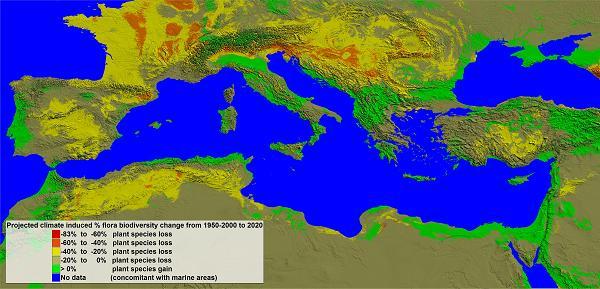I am a part-time Ph.D. student at the University of Reading and a member of the Centre for Plant Diversity and Systematics in the School of Biological Sciences since October 2009.
 The aim of my research is a biodiversity climatic change study of plants in the Mediterranean region.
The aim of my research is a biodiversity climatic change study of plants in the Mediterranean region.
Most of the work done to date has focused on developing methodologies to achieve this goal.
Two papers have been published to date (see below). The first paper discusses the development of filters to remove various erroneous data from plant species occurrence data. The second paper starts by explaining the need for a cluster computing approach for the efficient processing of thousands of plant species environmental niche models (ENMs). Due to the aggregate size of these models (around 3 Tb), we introduce a novel technique for downsizing them to reduce storage requirements. Finally, we show how we used the compute cluster to merge 4,209 plant ENMs to create plant climate-change biodiversity maps.
The map displayed illustrates the current state of this research. The Mediterranean basin is home to the world’s third largest plant biodiversity hot spot. There are around 25,000 plant species, half of which are endemic. Although there are areas in green predicting overall species gains, they are generally small. More worrying are the areas predicting significant species losses especially as global warming during the first decade of the 21st century advanced at a higher rate than that of the ‘aggressive’ IPCC, 4th assessment climate change model we used to create this map.
Due to the limited availability of plant species occurrence data, it was not possible to temporally filter this data. So using contemporary data of change in species cover of various alpine plant species, the next stage of research will attempt to ‘ground-truth’ the above map’s predictions.
Finally, by focusing on protected areas (e.g. national parks), falling within these maps, it is planned to derive more detailed information on the potential effects of climate change on biodiversity occurring within the biome and so aid administrators of regional, national and local biodiversity policy.
Published work
Heap M.J. & Culham A. (2010). Automated pre-processing strategies for species occurrence data used in biodiversity modelling. KES 2010, Part IV, LNAI, 6279: 517-526. Springer-Verlag Berlin Heidelberg.
Heap M.J., Culham, A & Osborne J. (2012). The Benefits of a Compute Cluster Approach to High Spatial Resolution Biodiversity Richness Modelling: Projecting the Impact of Climate Change on Mediterranean Flora. The International Journal of Climate Change: Impacts and Responses. Volume 4, 2012, http://on-climate.com/, ISSN 1835-7156.

